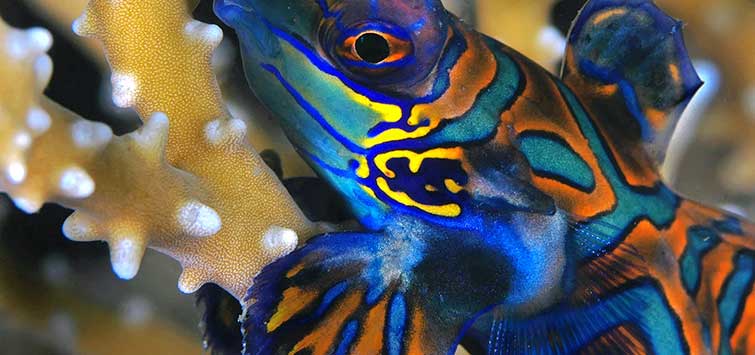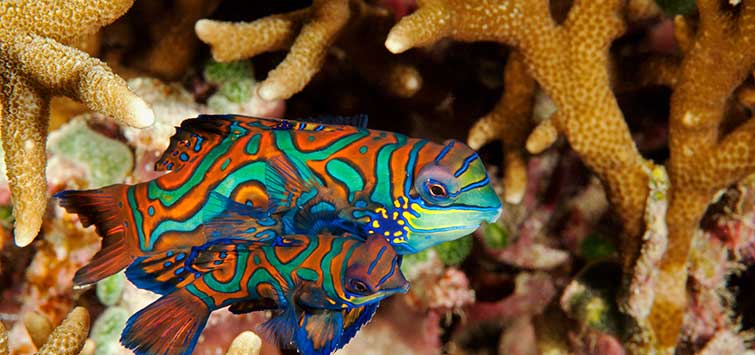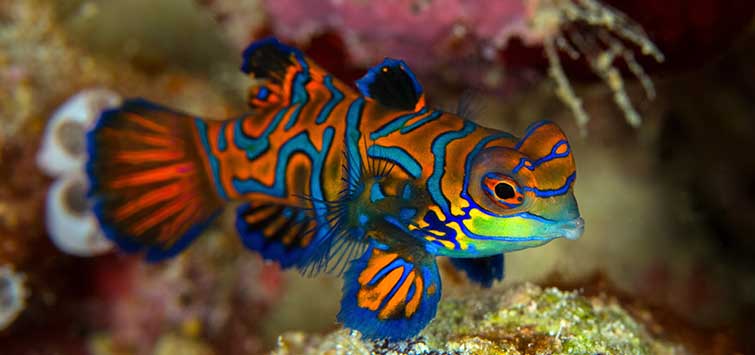Nano Mandarin
Author: Josh Day
Small reef tanks have long been considered out of the question for keeping mandarins, but the author shows that, with some attention to detail, the conscientious aquarist can pull it off.
Mandarin Basics
You rarely hear the words “mandarin” and “nano” together in a conversation concerning good fishkeeping. In fact, keeping a mandarin in a nano tank is almost universally regarded as a rookie mistake or the action of an ignorant or non-caring hobbyist. But I’m here to tell you about my personal experience with nano mandarin keeping and how I’ve kept my green mandarin alive, plump, and thriving since June 2005.
In the Nano Tank
I discovered the simple joys of nano keeping through a friend, and I set up my 10-gallon reef in early spring of 2005. The dazzling colors and unique beauty of the green mandarin immediately called to me the first time I saw one in a fish store’s display tank. Of course, the mandarin-in-a-nano stigma had me convinced I could never enjoy one in my humble 10-gallon. This seemed like such a waste, because a mandarin should make a wonderful nano addition, as they stay relatively small and are pretty hardy as long as they are getting enough food. I can also say I’ve never actually seen a mandarin in a 100-gallon tank; I’ve seen ones that supposedly contain mandarins, but I’ve never seen the fish for all the mountains of live rock!
Feeding Habits
Not to be confused with true gobies, green mandarin dragonets Synchiropus splendidus are renowned for their insatiable feeding habits and the difficulty in keeping them from starvation. In the wild, mandarins consume tiny flea-like organisms called copepods and amphipods, feeding constantly as they prowl over reefs. These “pods” scurry in and out of crevices in the reef and along the ocean floor, and they are in abundant supply in nature.
Because a captive reef can only contain so much live rock, a mandarin can wipe out a tank’s pod population in his constant search for food. This is why keeping a mandarin in a nano is generally regarded as impossible. However, a mandarin can die just as easily in a 100-gallon tank as it can in a 10-gallon if the animal’s feeding requirements are not met.
An Outside Food Source
When I started my mandarin-in-a-nano project in April of 2005, I was determined to meet the feeding requirements by farming pods outside the nano tank while I would meanwhile try to wean the mandarin onto mysis shrimp and ultimately prepared foods.
First I obtained several bottles of live copepods. I immediately poured a small portion into my 10-gallon nano to boost the tank’s pod population while I employed the rest in making a separate culture. I was going to use my pod farm to replenish the nano’s copepod population as needed. The farm was made up of two one-quart jars with airstones and some Chaetomorpha algae, as well as plastic dishwashing scrubbing pads as a means for transporting the pods to the main tank.
In addition to the culture, I created a “pod pile” consisting of live rock rubble and shells piled on top of two scrubbing pads in the back corner of the nano. Pod piles offer an in-tank refugium where pods can breed and live safely away from predators. Later I added a couple handfuls of Chaetomorpha in the other corner of the tank—chaeto offers the pods security as well as sustenance.
The First Candidate
Like so many mandarins, my first was emaciated and withered when I got it. A healthy mandarin should not have the tell-tale starvation lines on its side, but rather it should be uniformly plump and boasting large cheeks. Unfortunately, the majority of mandarins found in fish stores and in hobbyist tanks are too skinny. If your mandarin is indeed healthy, it should look plump and have no visible abdominal line. Also, take note of a healthy mandarin’s underside; it should be flat and at best slightly rounded, not concave. A sunken belly is a sign of a hungry, malnourished mandarin.
Doomed from the Start
So my first mistake was bringing home a mandarin that was likely doomed no matter what I did. His sides showed the two distinct lines and his stomach was well sunken. I did my best to keep him fed. I ordered several more bottles of live copepods that went straight into the tank, and also attempted to feed mysis shrimp, freshwater bloodworms, and several other foods. Note I did not use brine shrimp, either live or frozen, because brine shrimp has very little nutritional value.
I never once saw him definitely consume anything. In fact, the pod population may have increased during his tenure in my nano. At night, with the aid of a flashlight, I could see hundreds of tiny copepods and slightly larger amphipods scurrying about the sand and glass, and they were even in abundance in daytime under strong compact fluorescent lighting.
A Mysterious Death
After two months, my first attempt at mandarin nano keeping ended in failure when I found the fish dead, clearly from starvation, as his underside was totally collapsed into the body. I was baffled. Pods were crawling around the tank. How could he have starved and not have depleted the limited copepod population?
Trying Again
I was still engaged in my pod culture experiment and was not yet ready to admit defeat. I purchased my second mandarin on June 30, 2005. This one had a well-rounded body with no lines on the side and was quite active in the store tank. He was also considerably larger, nearly half an inch longer than my first mandarin. He had been in the store for two weeks and was in amazingly good shape.
The considerable pod population my first mandarin had left behind was decimated by the new mandarin within a week. I could no longer find more than three or four pods at any given time during a flashlight pod-spotting session. I was also able to clearly witness how a mandarin eats. When they catch a pod or a bit of food, the fish exhibits swallowing behavior which is quite different than their signature hunting and pecking over live rock. After a few days of watching my new mandarin, I could clearly differentiate when he caught something and when he did not.
I also observed the mandarin eating a few particles of freeze-dried cyclops and then spitting them out. As mandarins appear to be constantly pecking at something, the spitting action can be difficult to spot. As I learned with the first mandarin, the fish may appear to be eating, but what you are likely observing is their trademark pecking without swallowing.
Insufficient Pods
Despite his voracious appetite, in only three days he went from a slightly plump and healthy mandarin to exhibiting a line in his side as well as a sunken belly. I knew if I didn’t produce enough pods or find a viable, protein-rich food substitute, he would soon end up like my first mandarin.
At this point I gave up on my pod culture for several reasons. The pods did not appear to multiply in their culture jars. I had ordered from four different copepod suppliers and experienced the same disappointing results with each product. This may have been due to the products themselves or my natural system method of farming them, but regardless, I retired my cultures and have not tried again.
Always trying new high-protein foods, I began feeding capelin roe, purchased at an Asian food market. I smiled as I watched the orange fish eggs commonly found atop sushi instantly sink to the bottom of the tank. My smile suddenly changed to a look of wonder as the mandarin appeared and began to greedily feed. Piece by piece, sometimes cluster by cluster, he sucked up the roe as he hovered over the sand. There was no spitting out this time, no question whether the food was being consumed.
My Triumph
My mandarin has been thriving on sushi roe in my 10-gallon reef since July of 2005. I feed a half teaspoon of roe every day, offering some in a spot the fish has learned to come to, as well as distributing the rest throughout the tank for later grazing. While the fish’s main diet is capelin roe, I infrequently jumpstart the tank with fresh copepods. Daily feeding keeps his abdomen rounded and gives the limited population of pods a chance to breed and maintain a small but crucial presence.
Whether you are keeping a mandarin in a 10 or in a 100, keeping an observant eye on your fish will tell you if he is getting enough food. It only took days for my mandarin to clean out my 10-gallon, which was bristling with pods, and his sides and abdomen clearly showed he was still in need of sustenance.
If you have a large enough tank, you may be able to keep the pod population in sustainable numbers, and you may not need to find a food substitute. Watch your mandarin and routinely observe his shape, and do not assume he is getting enough food, no matter the size of your aquarium.

.png?h=595&iar=0&w=2781&hash=5FD5E69473BCC22199FBFA2FB71B6033)



